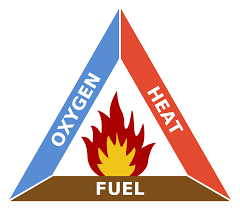Elements of fire
Objectives
What you should learn and remember from this lesson is the following:
- What three elements form a fire?
- What is the meaning of ‘heat’ and ‘fuel’? Give examples.
- What are the three techniques to extinguish a fire and how does that work?
Lesson
Any fire consists of the following three elements:

Whereby FUEL refers to any flammable material and HEAT to the relevant ignition temperature of the FUEL.
A flammable material can be a combustible, like paper or fabric, but can also be a liquid, gas, metal (battery) or fat/oil. Anything that can burn.
Heat to ignite a fire normally comes from an ignition or a lighter or matches. In the aircraft cabin heat that can ignite a fire can come from a burning cigarette or for examle from short-circuit in an electronic appliance. That can be an aircraft system like a power socket or the inflight entertainment system, but it can also be a mobile phone, power bank or any other battery-powered equipment.
Removing one of these three elements, will extinguish the fire.
Basic techniques to extinguish the fire are:
- STARVING: by removing or subdivide the flammable material
- SMOTHERING: by sufficiently reducing the oxygen
- COOLING: by reducing the temperature by means of a non-flammable liquid
Using Starving as an extinguishing technique is not really applicable in an aircarft cabin. It is often not possible to subdivide or remove the flammable material. An example of Starving is to close the gas supply in case of a gas line fire.
With Smothering, the supply of oxygen is being reduced. This can be accomplished by covering a fire with e.g. a fire blanket or by closing a locker or compartment containing the fire.
With Cooling, the temperature is being reduced to below the ignition temperature of the particular flammable material by throwing water over the fire.
